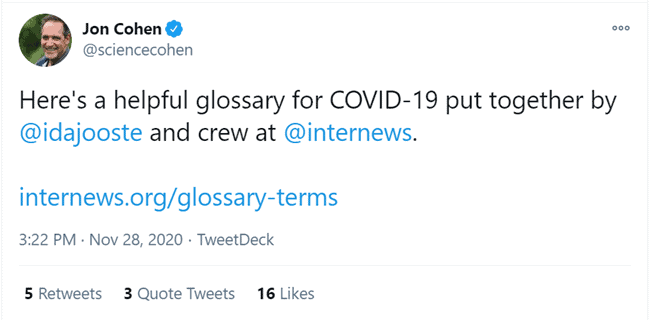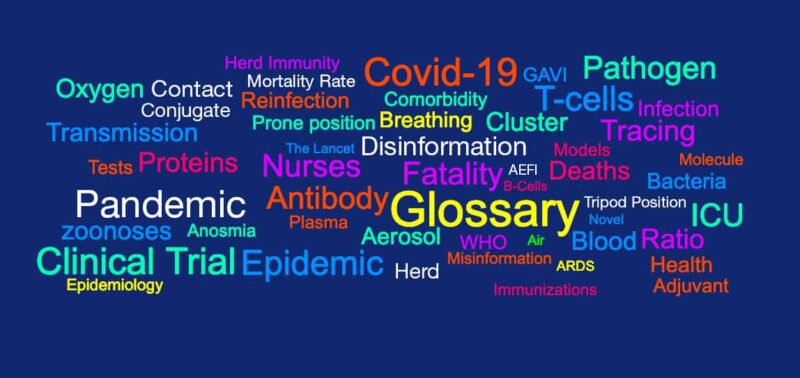Words Matter. Especially when we are dealing with an unprecedented global health crisis. As we approach the one-year anniversary of the first COVID-19 case in Wuhan, China, we know the toll this pandemic has taken. This year will go down in history as one of the most challenging of our century.
For journalists, making sense of the past 12 months has been like being in a marathon. If you never covered health before, chances are that you did so in 2020. Our collective vocabulary has expanded in ways we could not have imagined before. Terms like aerosol, herd immunity, long COVID and efficacy are here to stay. On social media, the hashtag #WeAreInThisTogether has taken on a new meaning.
It was in this context that the COVID-19 Glossary was conceived. Artyom Liss, a journalist, media manager and an Internews Pandemic Mentor was inspired to create a resource for journalists, content creators and health communicators. With the help of other Internews journalism trainers, he crowdsourced the most frequently used scientific terms around the COVID story and unpacked them one by one.
“I wanted to give journalists who do not regularly cover health and medicine the information and knowledge they need to write or talk about the pandemic,” says Liss. “It was critical for me to present these terms in a way that is both scientifically correct and easy-to-understand. Getting this balance right was sometimes hard, but I think we nailed it.”
With over 140 entries based on rigorous science and from credible sources, the Glossary is useful to counter misinformation and disinformation. This may be a reason why it is also appealing to more experienced journalists. Jon Cohen, a renowned science magazine writer on infectious diseases, gave it a shout out over Twitter.

This dynamic and open-ended resource developed by Internews can be easily updated and expanded. “At a time when journalists are dealing with the scourge of fake news and inaccurate information, a credible, data-rich resource like the one put together by Internews will provide a public service that I hope extends beyond the COVID-19 pandemic and encourages the practice of journalists to reference and use credible sources,” says Abhinandan Sekhri, Co-Founder and CEO of Newslaundry, India.
As a media development organization, Internews is committed to empowering local journalists with practical tools and resources. These offer audiences the news and information they need to make sound decisions, hold governments accountable and connect with each other. The Glossary is one such tool.
Adele Baleta, a science journalist, media consultant and an Internews pandemic mentor, who was instrumental in perfecting the Glossary reflects on its purpose. “I wanted it to be like a best friend. Something that can be kept close at hand and consulted whenever you need a simple explanation for a complex term, especially as deadlines approach. I wanted it to be easy to use and to explore.”
Baleta praises the versatility of this resource. “A click on one entry will take you to others and you won’t be misled. All the information is from credible sources. It’s stress-free, can be trusted and you can have fun with it. It’s been a mammoth effort pulling it together but as with friendship, I think it’s worth it.”
As multiple COVID vaccines are on the horizon, this Glossary will become even more relevant. Local journalists will have to explain the science behind vaccines to people who have grown skeptical of treatments and are bearing the brunt of this protracted crisis. Words have never mattered more.
